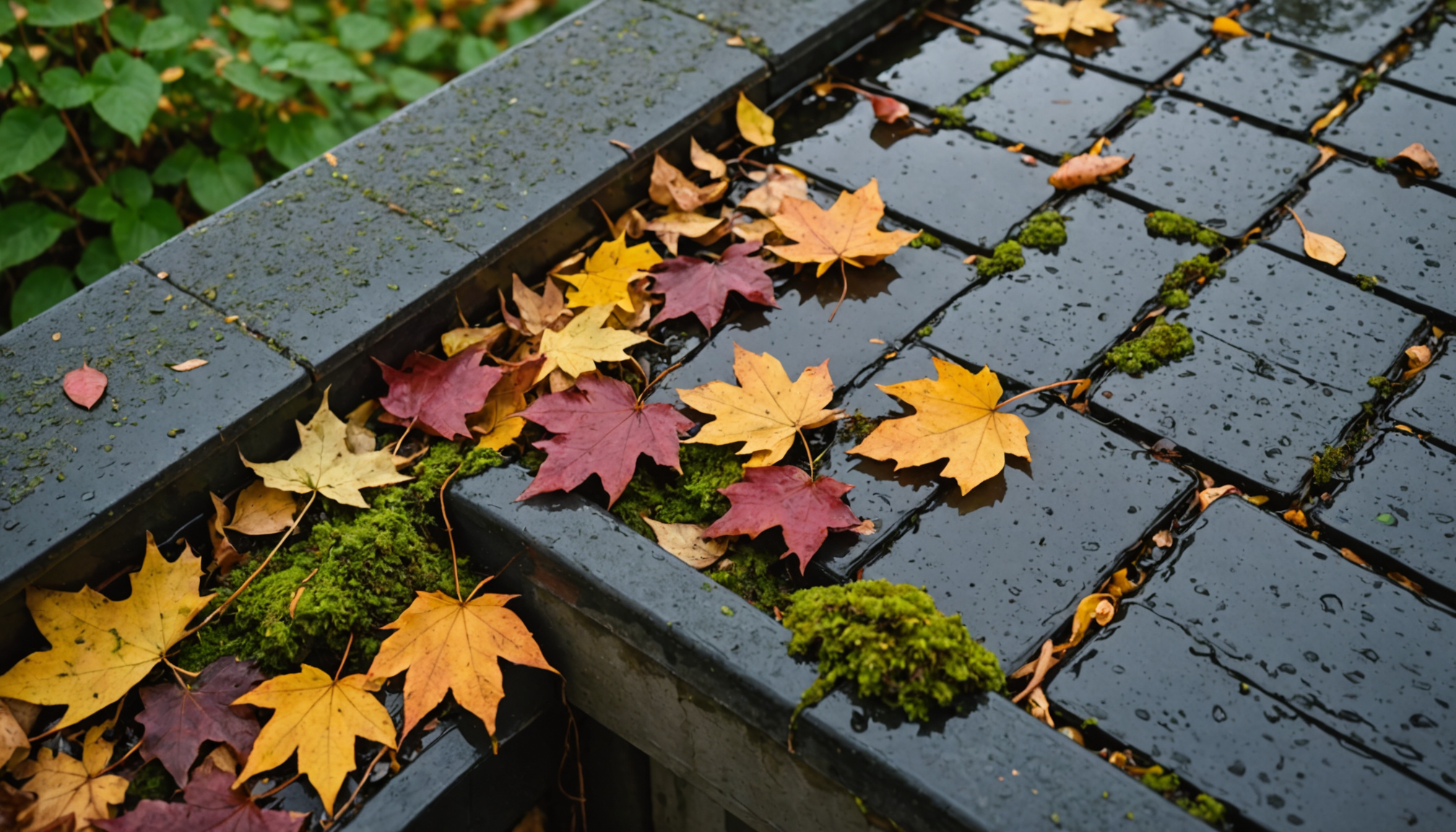Gutters are an essential component of a home’s infrastructure, serving the vital role of directing rainwater away from the roof and foundation. However, for gutters to function effectively, they must remain clear of obstructions. When gutters become clogged, it often leads to a host of potential issues for the home. Understanding the common causes of clogged gutters can aid homeowners in taking proactive measures to prevent blockages and maintain the efficiency of their gutter systems.
The primary reason gutters get clogged is due to the accumulation of debris. Over time, various elements, such as leaves, twigs, and dirt, can collect in gutters, particularly during the fall when trees shed their foliage. This debris can form a thick layer, obstructing the natural flow of water. Additionally, pollen, seeds, and small branches, especially during spring, can add to this buildup.
Another common cause of clogging is the growth of moss and algae. In humid or shaded environments, gutters can become breeding grounds for moss if they retain moisture for extended periods. This growth not only impedes water flow but can also further trap other types of debris.
Critters and pests also contribute to clogged gutters. Birds, squirrels, and insects often use gutters as a nesting ground or a route around the home. Their nests and waste materials can add significant blockages over time. Furthermore, smaller rodents and animals might carry food or bedding materials into the gutters, complicating the issue further.
Improperly installed or maintained gutters can aggravate the clogging problem. If gutters are not properly sloped, water can pool, increasing the chances of debris buildup. Cracks or separations at the gutter seams can also catch fragments, gradually leading to a blockage.
To facilitate a clearer understanding, here is a comparison of the potential contributors to gutter clogs:
| Cause | Description |
| Tree debris | Leaves, twigs, and seeds that accumulate, especially during fall and spring. |
| Moss/Algae | Moss growth in humid, shaded environments, retaining moisture and debris. |
| Animals/Insects | Bird nests, rodent materials, and insect activity contributing to blockages. |
| Installation Issues | Improper slopes or cracked seams causing water and debris accumulation. |
Identifying these causes is the first step towards effective gutter maintenance. Regular cleaning, appropriate maintenance, and investing in protective gutter covers are just some of the strategies that can be implemented to minimize the occurrence of clogs.
water damage to the roof
When gutters are clogged, a chain reaction begins that often leads to extensive damage to a home’s roof. This is primarily due to the inability of water to flow away from the structure, resulting in overflow. As the water cascades over the sides of the clogged gutters, it can pool on the roof, leading to various types of damage:
1. Shingle Damage:
– Water that backs up into the roof under shingles can cause them to warp or rot.
– Constant moisture can lead to shingles becoming soft, ultimately causing them to break or fall off.
– Damaged shingles expose the underlying layers of your roof to further water infiltration.
2. Soffit and Fascia Issues:
– The soffit, the underside of the roof’s overhang, and the fascia, the horizontal band running along the edge of the roof, can absorb water from overflowing gutters.
– Continuous exposure to moisture leads to the wood rotting or metal corrosion.
– Damaged soffits and fascia create entry points for pests and further water intrusion, which can spread to other parts of the roof.
3. Roof Leaks:
– Persistent water buildup can penetrate the roof deck and seep into your home’s attic or upper floors.
– Leaks may manifest as stains on your ceiling or walls.
– More severe leaks could result in structural damage to your home’s interior.
4. Ice Dams in Winter:
– In colder climates, clogged gutters can contribute to the formation of ice dams.
– As water overflows and freezes, it creates a dam that prevents the melting snow from properly draining.
– The trapped water can then seep back under the shingles and into the house.
To mitigate these problems, it’s essential for homeowners to ensure regular gutter maintenance throughout the year. This includes frequent inspections and cleanings, particularly after storms or heavy wind episodes. Additionally, installing gutter guards can help prevent debris buildup, allowing water to flow more freely through the system and significantly reducing the risk of roof damage. By taking these proactive steps, homeowners can safeguard their roofs against the potentially costly consequences of blocked gutters.
foundation and structural issues
Beyond causing problems for the roof, clogged gutters can lead to significant issues with the foundation and structural integrity of a home. When gutters are unable to channel water away due to blockages, the overflow can lead to water pooling around the foundation, which is a growing concern for homeowners looking to maintain the longevity and safety of their property.
Foundation Cracks and Shifting:
Water pooling near your home can penetrate the soil, increasing the moisture content and potentially causing the soil to expand or shift. This movement exerts pressure on the foundation walls, often resulting in cracks. Over time, these cracks can widen, allowing even more water to infiltrate your home’s foundation and basement. Seasonal freeze-thaw cycles can exacerbate this issue, causing the cracks to expand further and threatening the stability of the entire structure.
Basement Flooding:
Persistent water pooling can seep into basements, resulting in flooding or unwanted moisture accumulation. This not only threatens stored items and living spaces but also creates an ideal environment for mold and mildew growth. The presence of mold can have severe implications for indoor air quality, posing health risks to occupants and leading to costly remediation efforts.
Soil Erosion:
Poorly managed water flow due to clogged gutters can cause substantial erosion of the soil surrounding your home. As soil is washed away, the ground supporting the foundation becomes less stable, potentially leading to uneven settling. This settling can cause distress in the structural components of your home, such as fractures in walls, floors, and the roofline, sometimes requiring extensive repairs.
Damage to Concrete and Masonry:
Excess water exposure can lead to damage in concrete or brick elements of a home’s foundation, patio, or walkway areas. Water infiltrates small fissures in these materials, and as temperatures drop, the water freezes and expands, further widening the cracks and causing spalling and significant disintegration over time.
To alleviate these adverse effects, it is crucial to focus on preventative measures. Ensuring that downspouts are properly extended to channel water at least several feet away from the foundation is essential. Additionally, regular inspections and cleaning of gutters, especially before seasonal changes, can greatly diminish the likelihood of blockages. For added protection, consider installing underground drainage systems or french drains to facilitate efficient water evacuation, preserving both the foundation and broader structural integrity of your home. These proactive steps can help avert the costly and extensive repairs that disconnected or dysfunctional drainage systems might cause.
impact on landscaping and garden
When gutters are clogged, the effects aren’t limited to visible components of the home; they can also spill over into the surrounding landscape, negatively impacting your garden and the overall aesthetic appeal of your outdoor space. Undoubtedly, your landscaping represents a significant investment of time, money, and effort, making it imperative to understand how neglected gutters can erode its beauty and functionality.
Standing water resulting from blocked gutters can lead to the excessive saturation of soil. When water overflows, it drenches flower beds and lawns, which can disrupt plant roots. This waterlogging stifles the oxygen supply that roots need, resulting in wilting or root rot, and ultimately threatening the vitality of your garden plants. Furthermore, certain species are more sensitive to excess moisture and can suffer significantly, losing their vibrant blooms or, worse, dying off entirely.
Beyond the immediate threat to individual plants, water overflow can cause soil erosion. As water cascades over the edges of gutters, it can wash away nutrient-rich topsoil, undermining the very foundation of your landscaping efforts. This erosion not only disrupts your garden’s appearance but can unbalance the soil composition, making it less fertile and harming your plants’ overall health.
The disrupted water flow can also lead to unnatural water pooling across your yard, forming small “wetlands” that can drown grass and invite mosquitoes. These pests breed in standing water and can quickly become a nuisance, diminishing outdoor enjoyment and even posing health threats to your family and pets. Additionally, excess moisture creates a perfect breeding ground for mosses, fungi, and unwanted weeds, further displacing the carefully arranged components of your landscaping.
Properly functioning gutters guide rainwater towards specific drainage points, ensuring that water doesn’t directly impact your garden. To safeguard the time and money spent on landscaping, proactive measures should become routine. Periodically inspect your gutters for clogs, particularly before a predicted rainy season. If feasible, invest in gutter guards to minimize debris accumulation, thereby maintaining smooth water flow and preventing overflow into your garden areas. These preventative measures will not only protect your plants but will help maintain the curb appeal of your home by ensuring your garden remains a healthy, vibrant extension of your living space. Remember, a little maintenance goes a long way in preserving the serene beauty of your landscape while protecting your flora from the side effects of clogged gutters.
how to prevent gutter clogs
Regularly maintaining the gutters is key to preventing clogs and the numerous associated damages they can cause to your home. One of the first steps in maintaining gutters is scheduling periodic cleaning sessions. It’s recommended to clean your gutters at least twice a year, typically in the spring and fall. However, if your home is surrounded by trees that shed leaves and twigs, more frequent inspections and cleanings might be necessary to keep the gutters debris-free.
Using tools like a gutter scoop or a trowel can help in clearing out leaves and debris effectively. Additionally, employing a garden hose to flush out any remaining residue ensures that the water flows freely through the downspouts. Furthermore, consider investing in a gutter guard or screen. These accessories are designed to prevent larger debris particles from entering the gutters while allowing water to pass through unimpeded. They come in varying designs, such as mesh, reverse curve, or bottle brush, allowing homeowners to choose according to their specific needs and budget.
Beyond cleaning, it’s essential to regularly check the alignment and positioning of the gutters. Ensure the gutters are sloped correctly, approximately a quarter inch for every 10 feet, to facilitate the efficient flow of water towards the downspouts. If you notice water pooling in any section, it may indicate a need for re-alignment. Tightening any loose screws or brackets and sealing any visible leaks or cracks with gutter sealant can prevent premature wear and tear.
Moreover, the downspouts, which guide water away from the foundation, should also be regularly inspected. Ensure they are not blocked and are extended adequately, ideally at least six feet away from the foundation. During winter, take extra precautions by clearing accumulated snow or ice and considering heating cables to prevent the formation of damaging ice dams.
Finally, don’t underestimate the benefit of professional gutter maintenance services. Experienced professionals can provide a thorough cleaning, checking for issues you might overlook while also offering advice tailored to your home’s specific needs. By implementing these preventative strategies, you protect your home’s structural integrity and ensure that your gutters function correctly for years to come.
In conclusion, clogged gutters pose a significant risk to various components of your home, potentially leading to costly repairs and damages if left unchecked. By addressing the common causes of blockages and investing in regular maintenance, such as cleaning, inspecting, and implementing preventative tools like gutter guards, homeowners can protect their property from a cascade of issues. Maintaining a system for proper water drainage is not merely an aesthetic consideration but a critical component of preserving the structural integrity and longevity of your home. Prioritizing gutter health ensures peace of mind, safeguarding against the preventable yet substantial hazards that clogged gutters present.


